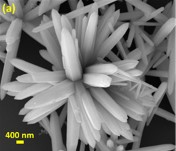Needle flower-like ZnO-based chemiresistive sensor for efficient detection of formaldehyde vapors
DOI:
https://doi.org/10.61343/jcm.v1i02.26Keywords:
ZnO, needle flower, chemiresistive, gas sensor, formaldehydeAbstract
The development of a chemiresistive sensor that uses needle-flower-like ZnO to effectively detect formaldehyde vapors is highlighted in the paper. The hydrothermal process at low temperature was used to prepare the sensing material. The morphological and structural characteristics of the synthesized material were assessed using X-ray diffraction (XRD) and field emission scanning electron microscopy (FESEM). Using a micropipette, the sensing material was transferred to the surface of the gold-based interdigitated electrodes to fabricate the device. The fabricated sensor was found to be more selective and sensitive to formaldehyde in the sensing study. The results showed an approximate response of 8 at 250 °C and 75 ppm formaldehyde. The lowest detection limit of the sensor was calculated as 480 ppb. The sensor has a great potential to monitor formaldehyde vapors in the indoor environment.
References
P. Wahed, M. A. Razzaq, S. Dharmapuri and M. Corrales, Food chemistry 202, 476-483 (2016).
Y. Huang, S. S. Ho, Y. Lu, R. Niu, L. Xu, J. Cao and S. Lee, in Molecules (2016), Vol. 21.
C. National Research, Review of the Formaldehyde Assessment in the National Toxicology Program 12th Report on Carcinogens. (The National Academies Press, Washington, DC, 2014).
A. Dorieh, M. Farajollah Pour, S. Ghafari Movahed, A. Pizzi, P. Pouresmaeel Selakjani, M. Valizadeh Kiamahalleh, H. Hatefnia, M. H. Shahavi and R. Aghaei, Progress in Organic Coatings 165, 106768 (2022).
U. N. Das, P. Jana, V. Dhanabalan and M. Xavier, Int J Curr Microbiol App Sci 7 (11), 2316-2322 (2018).
S. Dey, S. Santra, S. Sen, D. Burman, S. K. Ray and P. K. Guha, IEEE Sensors Journal 18 (14), 5656-5661 (2018).
J. Namieśnik, T. Górecki, B. Kozdroń-Zabiega ła and J. Łukasiak, Building and Environment 27 (3), 339-356 (1992).
B. Mahata, K. Dixit, S. Acharyya, P. Banerji and P. K. Guha, IEEE Sensors Letters 7 (8), 1-4 (2023).
K. C. Gupta, A. G. Ulsamer and P. W. Preuss, Environment International 8 (1-6), 349-358 (1982).
S. Acharyya and P. K. Guha, ACS Applied Electronic Materials 5 (6), 3446-3453 (2023).
M. Hunter, K. Bartle, P. Seakins and A. Lewis, Analytical Communications 36 (3), 101-104 (1999).
J. Schenk, D. D. Carlton, J. Smuts, J. Cochran, L. Shear, T. Hanna, D. Durham, C. Cooper and K. A. Schug, Environmental Science: Processes & Impacts 21 (2), 214-223 (2019).
G. Korotcenkov, Materials Science and Engineering: B 139 (1), 1-23 (2007).
S. Chaudhary, A. Umar, K. K. Bhasin and S. Baskoutas, in Materials (2018), Vol. 11.
S. Banerjee, P. Bhattacharyya and C. K. Ghosh, Applied Physics A 123 (10), 640 (2017).
S. Dey, S. Nag, S. Santra, S. K. Ray and P. K. Guha, Microsystems & Nanoengineering 6 (1), 35 (2020).
H. Ji, W. Zeng and Y. Li, Nanoscale 11 (47), 22664-22684 (2019).

Downloads
Published
How to Cite
Issue
Section
Categories
License
Copyright (c) 2023 Bidesh Mahata, Soumen Giri, Pallab Banerji, Prasanta Guha

This work is licensed under a Creative Commons Attribution 4.0 International License.
Copyright© by the author(s). Published by journal of Condensed Matter. This is an open access article distributed under the terms of the Creative Commons Attribution (CC BY) license (https://creativecommons.org/licenses/by/4.0/), which permits unrestricted use, distribution, and reproduction in any medium, provided the original author(s) and source are credited.









